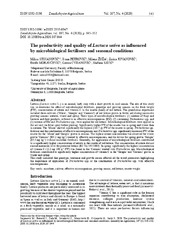Приказ основних података о документу
The productivity and quality of Lactuca sativa as influenced by microbiological fertilisers and seasonal conditions
| dc.creator | Stojanović, Milica | |
| dc.creator | Petrović, Ivana | |
| dc.creator | Zuza, Milena | |
| dc.creator | Jovanović, Zorica | |
| dc.creator | Moravčević, Đorđe | |
| dc.creator | Cvijanović, Gorica | |
| dc.creator | Savić, Slađana | |
| dc.date.accessioned | 2021-08-04T12:11:55Z | |
| dc.date.available | 2021-08-04T12:11:55Z | |
| dc.date.issued | 2020 | |
| dc.identifier.issn | 1392-3196 | |
| dc.identifier.uri | http://RIVeC.institut-palanka.rs/handle/123456789/266 | |
| dc.description.abstract | Lettuce (Lactuca sativa L.) is an annual, leafy crop with a short growth in cool season. The aim of this study was to determine the effect of microbiological fertilisers, genotype and growing seasons on the fresh weight (FW), concentration of nitrate and vitamin C in the rosette (head) of red lettuce. The greenhouse experiment included three cultivars ('Murai', 'Gaugin' and 'Carmesi') of red lettuce grown in fertile soil during successive growing seasons: autumn, winter and spring. Three types of microbiological fertilisers: (1) mixture of fungi and bacteria and their products, referred to as effective microorganisms (EM), (2) containing Trichoderma spp. and (3) mixture of EM and Trichoderma spp., were applied for red lettuce. Microbiological fertilisers were applied in the soil and via foliar spray before planting. Significantly higher FW of the rosette was in spring and winter than in autumn. The 'Murai' showed significantly the highest (264.7 g) FW of the rosette in spring. Trichoderma spp. fertiliser and the combination of effective microorganisms and Trichoderma spp. significantly increased FW of the rosette for the 'Murai' and 'Gaugin' grown in autumn. The highest nitrate concentration was observed for winter grown 'Carmesi' (805.2 mg kg(-1)) treated by effective microorganisms, and the lowest for spring grown 'Gaugin' (62.2 mg kg(-1)) without microbial fertilisers. Generally, the application of microbiological fertilisers contributed to a significantly higher concentration of nitrate in the rosette of red lettuce. The concentration of nitrate did not exceed maximum level for protected lettuce (EC No 563/2002). In spring, significantly the highest concentration of vitamin C (12.2 mg 100 g(-1) FW) was found in the 'Carmesi' treated with Trichoderma spp. Microbiological fertilisers contributed to significantly higher concentration of vitamin C in the 'Gaugin' and 'Carmesi' grown in winter and spring. This study indicated that genotype, treatment and growth season affected all the tested parameters highlighting the importance of application of Trichoderma spp. or the combination of Trichoderma spp. with effective microorganisms. | en |
| dc.publisher | Lithuanian Research Centre Agriculture & Forestry, Kedainiu R | |
| dc.relation | company "Iceberg Salat Centar", Belgrade, Serbia | |
| dc.rights | openAccess | |
| dc.rights.uri | https://creativecommons.org/licenses/by-nc-nd/4.0/ | |
| dc.source | Zemdirbyste-Agriculture | |
| dc.subject | ascorbate | en |
| dc.subject | cultivar | en |
| dc.subject | effective microorganisms | en |
| dc.subject | growing season | en |
| dc.subject | red lettuce | en |
| dc.subject | rosette weight | en |
| dc.title | The productivity and quality of Lactuca sativa as influenced by microbiological fertilisers and seasonal conditions | en |
| dc.type | article | |
| dc.rights.license | BY-NC-ND | |
| dc.citation.epage | 352 | |
| dc.citation.issue | 4 | |
| dc.citation.other | 107(4): 345-352 | |
| dc.citation.rank | M23 | |
| dc.citation.spage | 345 | |
| dc.citation.volume | 107 | |
| dc.identifier.doi | 10.13080/z-a.2020.107.044 | |
| dc.identifier.fulltext | http://RIVeC.institut-palanka.rs/bitstream/id/613/5301.pdf | |
| dc.identifier.scopus | 2-s2.0-85092373089 | |
| dc.identifier.wos | 000580818600008 | |
| dc.type.version | publishedVersion |


